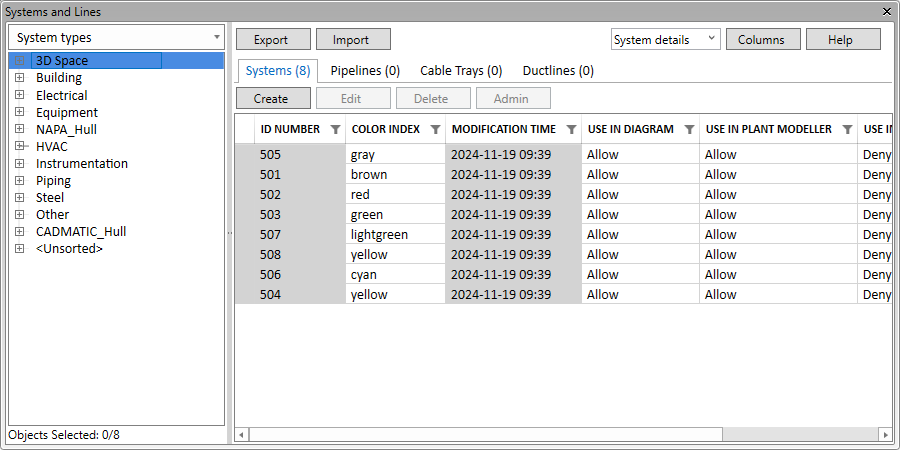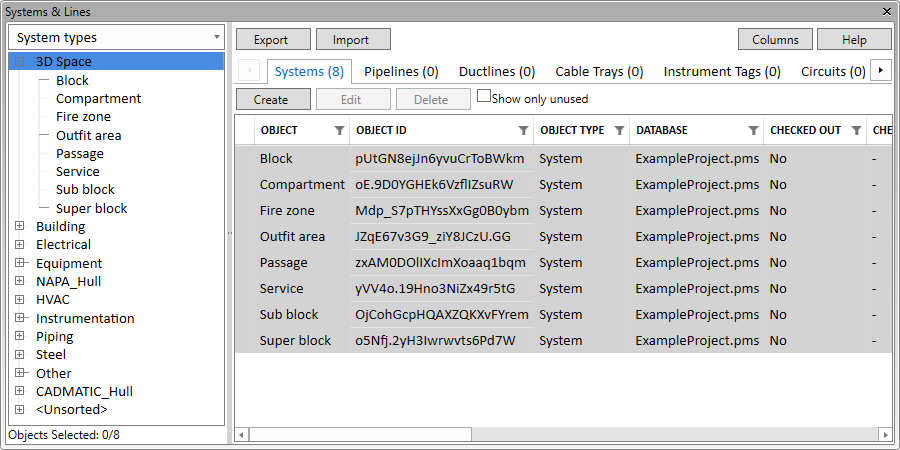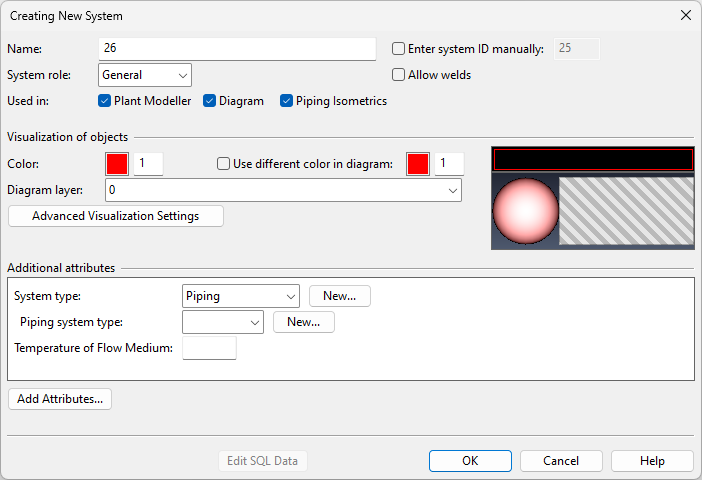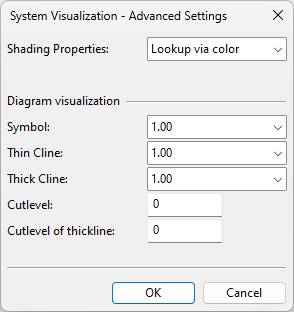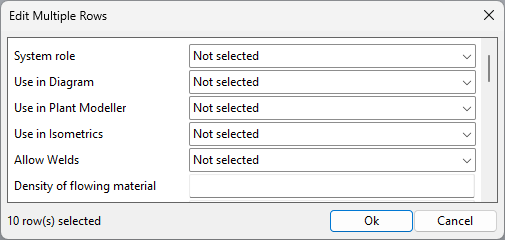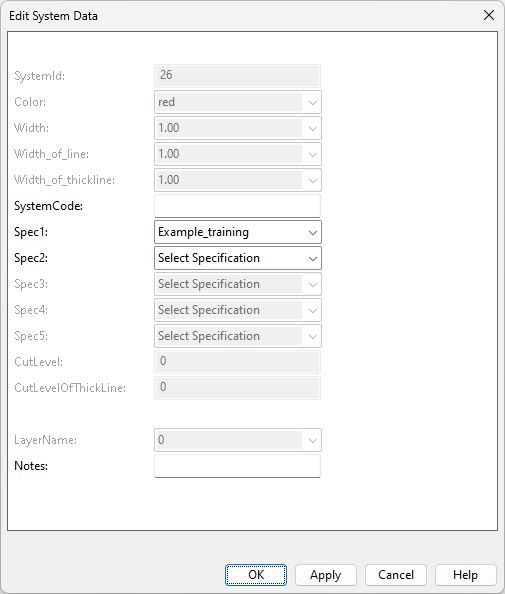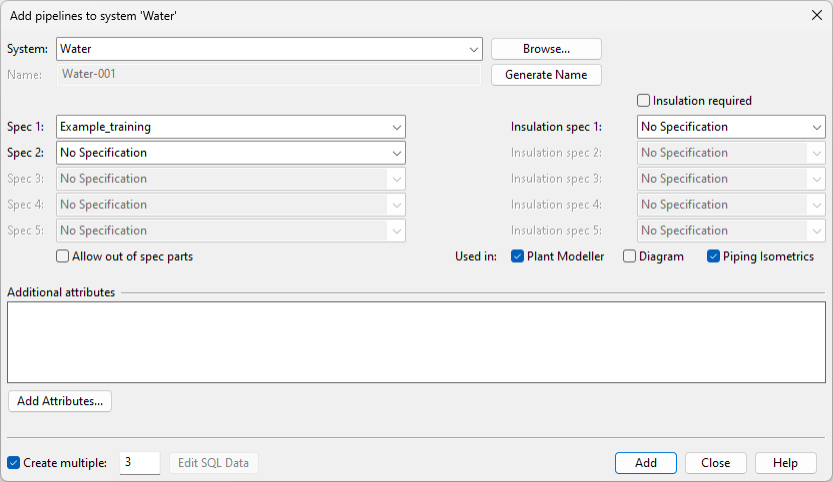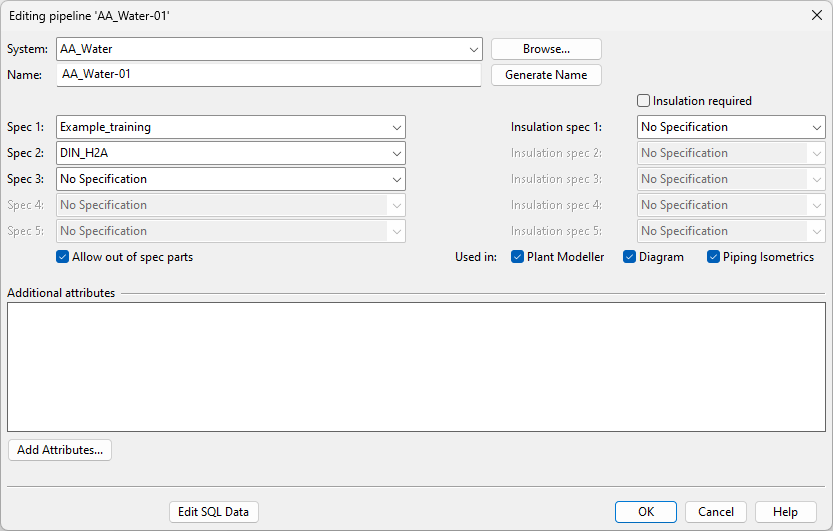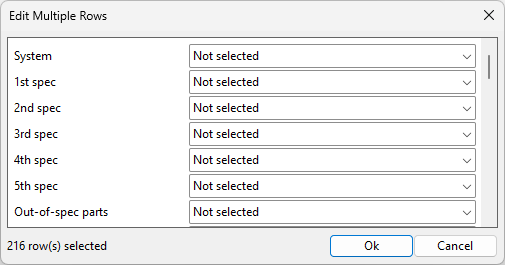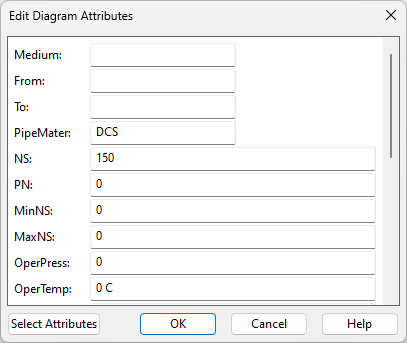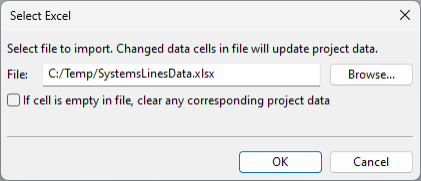Systems and Lines
In the Systems and Lines dialog, you can create, edit, and delete systems and lines. The left pane lists system types and systems, and selecting entities from that pane displays the associated information on the tabs in the right pane.
-
When opened from Plant Modeller, the dialog allows managing Systems, Pipelines, Cable Trays, and Ductlines.
-
When opened from P&ID, the dialog allows managing Systems, Pipelines, Ductlines, Cable Trays, Instrument Tags, and Circuits, and also enables filtering out systems and lines that already contain objects.
You can modify the data directly in the dialog or through export–import. Some of the actions described below may require administrator permissions, depending on the configuration of the related COS object types.
Creating systems
You can create new systems. Systems are COS objects that have specific System COS attributes.
Do the following:
-
In the left pane of the Systems and Lines dialog, select the system type for the new system.
Tip: You can also change the system type later, in the SYSTEM TYPE column of the Systems tab.
-
Do one of the following:
-
To start creating the new system with default settings, select Create > New.
-
To start creating the new system with the settings of an existing system, select Create > New from template, select the system to use as the template, and click OK.
The Creating New System dialog opens.
-
-
Enter the following information for the new system.
Setting
Description
The system's name can contain up to 100 characters; any characters beyond this limit will be cut off.
We do not recommend using special characters or spaces in the name.
The system ID number is a unique system identifier that cannot be changed later. Model objects store the system ID to bind themselves to a system.
You can either use the automatically assigned number or enter the system ID manually.
-
ID numbers 1–5999 can be used for user-defined systems.
-
ID numbers 6000–8191 are reserved by Cadmatic.
Specific sub-ranges are used in software integration. The systems that use these ID numbers are automatically created if the related software is installed:
-
ID numbers 6100–6199 are for NAPA related systems.
-
ID numbers 6200–6299 are for Tekla related systems.
Similarly, we recommend that user organizations reserve certain ranges for different purposes. For example, ID numbers 1-9 could be related to building, 10-19 to equipment, 300-400 to piping, and so on. This method makes it easier to make selections based on these ID ranges. For more information on setting the conditions for object selection, see Query test editor.
The system's role in the applications.
-
General – Most systems should have this role.
-
Cableway – Only systems that define cable trays should have this role. Selecting this role displays additional Definitions for Cable Router options.
-
Cable – Only systems that define cables should have this role. Selecting this role displays additional Definitions for Cable Router options.
For more information on the Cable Router related roles, see Cable tray systems and lines.
If selected, objects that use this system can be welded.
This setting is available when System role is either 'General' or 'Cableway'.
If selected, the system is visible in Plant Modeller.
If selected, the system is visible in P&ID, and you can define the options Use different color in diagram and Diagram layer.
If selected, the system is visible in Piping Isometrics & Spools.
Visualization of objects
The color of the system in non-shaded views.
The color can be selected from the Colors configuration by clicking the color palette or entering the index number of the desired color.
The color of the system in shaded views can be set in the Advanced Visualization Settings.
If selected, specifies the color of the system within the P&ID application.
The color can be selected from the Colors configuration by clicking the color palette or entering the index number of the desired color.
The layer where objects using this system are assigned when a P&ID diagram is exported. See also Drawing export configuration.
Opens the System Visualization – Advanced Settings dialog.
-
Shading Properties – If set to 'Lookup via color', the Color setting is used to find a matching color for shaded objects. Alternatively, you can select a particular shading style (which are defined in the Surface shading setup configuration) from the drop-down list.
-
Symbol – The linewidth of diagram symbols using this system.
-
Thin Cline – The linewidth of thin connection lines using this system.
-
Thick Cline – The linewidth of thick connection lines using this system.
-
Cutlevel – The cut level [0,255] of connection lines drawn with a thin line.
-
Cutlevel of thickline – The cut level [0,255] of connection lines drawn with a thick line, such as the 'Primary pipe' in the CADMATIC example project.
This works so that when thin and thick connection lines intersect and visual cuts are enabled in Cut Parameters, the line whose system has the smaller cut level value will be cut.
If System role is 'Cableway', select which interference classes to allow in cable trays that use this system.
If System role is 'Cable', select which interference class to assign to cables that use this system.
You can add and remove system attributes. Lines inherit their system's attributes, but they can also override the inherited value at line level.
For example, when a designer is selecting a system, an attribute based on a dynamic hierarchy can provide useful information to the designer.
-
-
Click OK.
Editing systems
You can edit a system's settings one field, one system, or multiple systems at a time. You can edit both the COS properties and the SQL data of the systems.
Do the following:
-
In the Systems and Lines dialog, do one of the following:
-
Select a single data value, type the new value over the existing value, and press Enter.
-
Select a single system, and click Edit.
-
Select multiple systems with Shift+click or Ctrl+click, and click Edit.
-
-
If editing a single system, the system editor dialog opens, and you can edit all the settings that were defined when Creating systems except the system ID. In addition, you can click Edit SQL Data to edit the system's data in the SQL database—see Editing system attributes (SQL data).
-
If editing multiple systems, the Edit Multiple Rows dialog opens, displaying the editable fields that the systems have in common. Initially, all fields show either 'Not selected' or an empty value. This indicates that they will maintain their current value unless you input a new one. Accordingly, select or type a new value in the fields where you want to change the value for all selected systems. Note that you will only be able to undo these changes by manually restoring the values. Then click Ok.
Editing system attributes (SQL data)
When editing a single system, clicking Edit SQL Data opens the Edit System Data dialog.
In this dialog, you can edit the system specific attributes that are stored in the SQL database of P&ID.
Deleting systems
You can delete systems that are not referenced by lines.
Do the following:
-
In the Systems and Lines dialog, select the systems you want to delete.
-
Click Delete. You are prompted to confirm the action.
Creating lines
You can create new pipelines, ductlines, and cable trays. Every line object must be assigned to a system; in this example, we add a new pipeline to the 'Water' system.
Do the following:
-
In the left pane of the Systems and Lines dialog, select the system for the new line, such as Water.
-
Select the line type specific tab, such as Pipelines.
-
Do one of the following:
-
To start creating the new line with default settings, select Create > New.
-
To start creating the new line with the settings of an existing line, select Create > New from template, select the line to use as the template, and click OK.
The Add pipelines to system 'Water' dialog opens.
-
-
Enter the following information for the new line.
Setting
Description
The system of the line.
The name of the line.
The default name is derived from the Name Generation Rules. You can edit the name here, and if necessary, you can restore the automatically generated name by clicking Generate Name.
Note: If you edit the name and then create multiple lines, only the first line will use the edited name—subsequent lines will still adhere to the name generation rules.
The specifications that the pipeline, ductline, or cable tray is to use.
If selected, also parts not included in specifications can be used in the line.
If selected, designers must select at least one insulation specification when routing a pipeline or ductline.
The insulation specifications that the pipeline or ductline is to use.
If selected, the pipeline is visible in Plant Modeller.
If selected, the pipeline is visible in P&ID.
If selected, the pipeline is visible in Piping Isometrics & Spools.
Either allows the cable tray to inherit the interference classes from the system or specifies the interference classes the cable tray is to use.
You can add and remove line attributes. Model objects inherit their line's attributes, but they can also override the inherited value at object level.
-
Select Create multiple to create more than one line, and specify the number of lines to create.
-
Click Add.
-
If the Edit Diagram Attributes dialog opens, specify the required attribute values, and click OK.
Editing lines
You can edit a line's settings one field, one line, or multiple lines at a time. You can edit both the COS properties and the SQL data of the lines.
Do the following:
-
In the Systems and Lines dialog, do one of the following:
-
Select a single data value, type the new value over the existing value, and press Enter.
-
Select a single line, and click Edit.
-
Select multiple lines with Shift+click or Ctrl+click, and click Edit.
-
-
If editing a single line, the line editor dialog opens, and you can edit all the settings that were defined when Creating lines. In addition, you can click Edit SQL Data to edit the line's data in the SQL database—see Editing line attributes (SQL data).
-
If editing multiple lines, the Edit Multiple Rows dialog opens, displaying the editable fields that the lines have in common. Initially, all fields show either 'Not selected' or an empty value. This indicates that they will maintain their current value unless you input a new one. Accordingly, select or type a new value in the fields where you want to change the value for all selected lines. Note that you will only be able to undo these changes by manually restoring the values. Then click Ok.
Editing line attributes (SQL data)
When editing a single pipeline, clicking Edit SQL Data opens the Edit Diagram Attributes dialog.
In this dialog, you can edit the pipeline specific attributes that are stored in the SQL database of P&ID.
Deleting lines
You can delete lines that are not referenced by model objects.
Do the following:
-
In the Systems and Lines dialog, select the lines you want to delete.
-
Click Delete. You are prompted to confirm the action.
Exporting systems and lines
Systems and lines can be exported into a Microsoft Excel file. In the exported file, all the systems are included in the same sheet, all the pipelines are in another sheet, and so on.
Do the following:
-
In the left pane of the Systems and Lines dialog, select what to export:
-
Select a system type to export all its systems and their lines.
-
Select a specific system to only export that system and its lines.
-
-
Use the Columns filter to specify which columns of the table view to include in the export file.
-
Click Export. A file browser dialog opens.
-
Specify the export location and file name, select whether to export a macro-enabled (.xlsm) Excel file instead of a regular (.xlsx) file, and click Save.
When the export completes, the export file opens automatically.
Importing systems and lines
Systems and lines can be updated by importing a Microsoft Excel file. The import will only update COS objects whose object IDs match the IDs found in the import file.
Do the following:
-
In the Systems and Lines dialog, click Import. The Select Excel dialog opens.
-
Select the file to import.
-
If you select the If cell is empty in file, clear any corresponding project data option, the import will be able to remove your current system or line data if the respective field is empty in the import file.
-
A preview of the imported data is shown in the dialog. Changed values are highlighted with a yellow background. Select whether to Accept Changes or Cancel Changes.
Managing system and line ownership
You can manage the ownership of system and line objects in a distributed COS network.
Do the following:
-
In the Systems and Lines dialog, select the system or line whose ownership you want to manage.
-
Click Admin, and select the applicable command:
-
Request ownership from master
-
Request ownership from replica
-
Relinquish ownership
-
Forcibly cancel check out
-
Take ownership
For general information on these commands, see Getting ownership from replica and Ownership.
-
